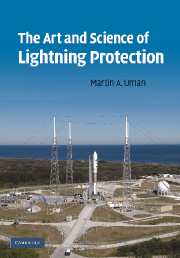Book contents
- Frontmatter
- Contents
- Preface
- 1 What is lightning?
- 2 Lightning damage
- 3 General methods for lightning protection: Faraday cages, topological shields; and more practical approaches: cone of protection and rolling sphere methods
- 4 Structure protection: air terminals and down conductors
- 5 Structure protection: grounding
- 6 Surge protection for electronics in low-voltage electrical systems
- 7 Humans and animals
- 8 Lightning warning
- 9 Airships, airplanes, and launch vehicles
- 10 Ships and boats
- 11 Trees
- 12 Overhead and underground power and communication lines
- 13 Lightning elimination
- 14 So, what do we know and what don't we know about lightning protection?
- Index
- References
12 - Overhead and underground power and communication lines
Published online by Cambridge University Press: 17 November 2009
- Frontmatter
- Contents
- Preface
- 1 What is lightning?
- 2 Lightning damage
- 3 General methods for lightning protection: Faraday cages, topological shields; and more practical approaches: cone of protection and rolling sphere methods
- 4 Structure protection: air terminals and down conductors
- 5 Structure protection: grounding
- 6 Surge protection for electronics in low-voltage electrical systems
- 7 Humans and animals
- 8 Lightning warning
- 9 Airships, airplanes, and launch vehicles
- 10 Ships and boats
- 11 Trees
- 12 Overhead and underground power and communication lines
- 13 Lightning elimination
- 14 So, what do we know and what don't we know about lightning protection?
- Index
- References
Summary
Overview
Both overhead (above-ground) and underground power and communication lines are susceptible to lightning-caused interruption and permanent damage. In an open field, the probability of lightning striking a buried cable is less than, but not that much different from, the probability of its striking an overhead line, as we shall discuss in Section 12.3. If a lightning flash would randomly strike the ground in the “near vicinity” of the location of either an underground or an overhead line in the case where the line were not present, that lightning would likely strike the line when the line was present. “Near vicinity” is typically a horizontal distance of some tens of meters. The attraction of lightning to objects projecting above ground level has been discussed in Section 1.5 and Section 3.3 and will be further considered in this section.
The number of strikes to an overhead power line per kilometer of line per year, Nkm, can be roughly calculated by using the concept of an “equivalent collective area” on the ground in which the lightning would strike if the line were not there (see Section 1.5). We assume that all flashes that would have hit ground within a horizontal distance equal to two line heights on either side of the line center (if the line were not there) will strike the line. The resulting equivalent collective area is shown shaded in Fig. 12.1. For a length of line ℓ, that area is 4hℓ, where h is the line height.
- Type
- Chapter
- Information
- The Art and Science of Lightning Protection , pp. 199 - 219Publisher: Cambridge University PressPrint publication year: 2008
References
- 1
- Cited by



